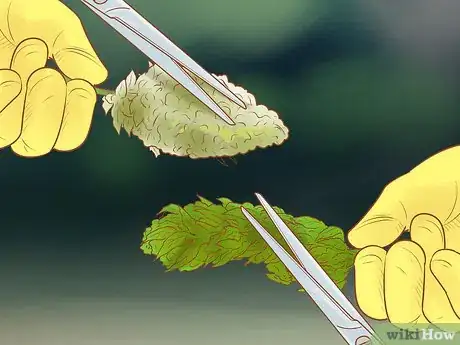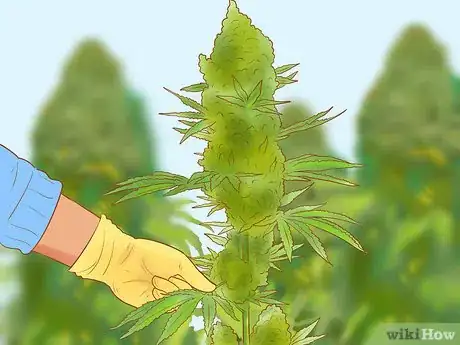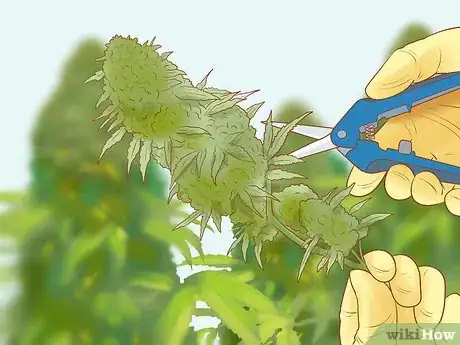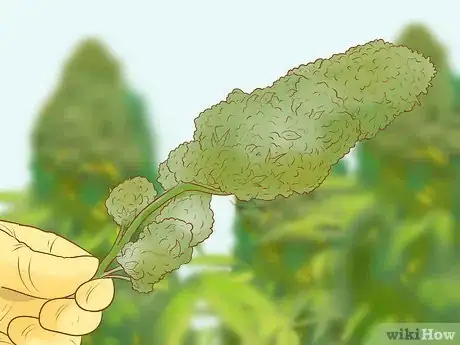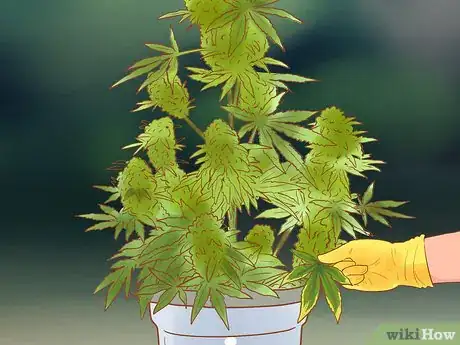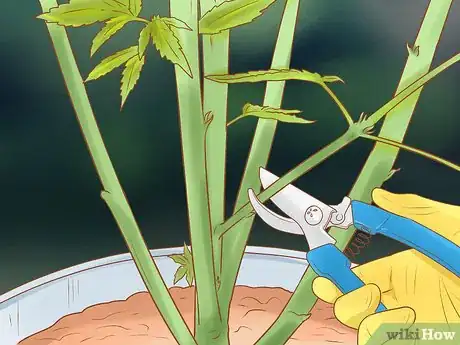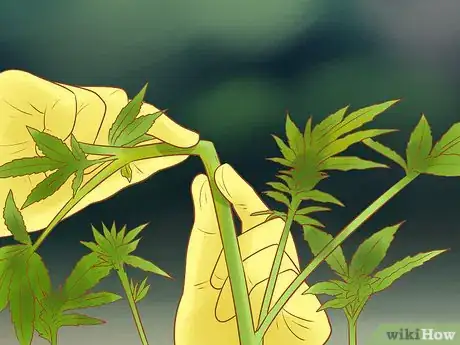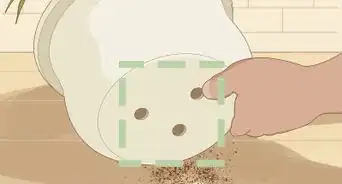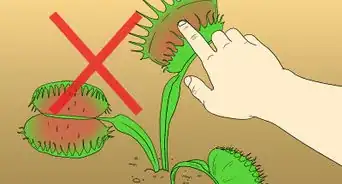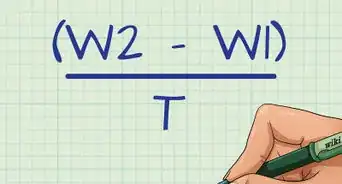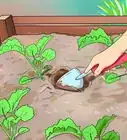This article was co-authored by Lauren Kurtz. Lauren Kurtz is a Naturalist and Horticultural Specialist. Lauren has worked for Aurora, Colorado managing the Water-Wise Garden at Aurora Municipal Center for the Water Conservation Department. She earned a BA in Environmental and Sustainability Studies from Western Michigan University in 2014.
There are 11 references cited in this article, which can be found at the bottom of the page.
wikiHow marks an article as reader-approved once it receives enough positive feedback. In this case, 93% of readers who voted found the article helpful, earning it our reader-approved status.
This article has been viewed 857,325 times.
Marijuana plants must be well cared-for and carefully harvested. Wear gloves and choose the time you trim your plants carefully. Trim the top off your plant to allow the leaves to get more light. Remove dead, yellow leaves and smaller buds from the lower portion of the plant. Don’t over-prune your marijuana plant or you could diminish its growth potential.
Steps
Getting Ready
-
1Wear gloves. The marijuana plant’s resin can be difficult to wash off. Wearing disposable rubber gloves will protect your hands from its sticky buds.[1]
-
2Use the right tools. Marijuana plants are fragile and can be sensitive to rough treatment. Trimming your plant must be done carefully. Sharp sewing shears or a sharp kitchen knife should be adequate to trim your plant.[2]
- Fiskars shears are a good option for trimming.
- Gardening shears are also commonly used to trim marijuana.[3]
- Large fan leaves can be plucked with your fingers, as well as clipped with scissors or shears.
Advertisement -
3Arrange a system to separate your trimmings. You should not simply discard the leaves you trimmed. They can be used to make marijuana foodstuffs or hashish. So before trimming your marijuana plants, set three cookie sheets or other wide containers near the plants you’ll be trimming. On one sheet, set untrimmed buds. On the second sheet, set newly trimmed buds. And on the last sheet, set the leaves and other plant matter you trim from the plant.[4]
-
4Harvest your plant at the appropriate time. The top of your marijuana plant should have a cluster of white hairs sticking out the top of it. These are the plant’s pistils, or reproductive organs. As the plant ages, these pistils will change from white to brown. When about 70% of the pistils have darkened to a reddish brown, your plant is ready for harvest.[5]
-
5Decide whether to wet trim or dry trim. Most people trim their marijuana plants before drying them. This is known as a “wet trim.” A wet trim makes it easier to separate leaves from buds, and produces better-looking buds. However, some people trim the plants after the buds of the plant have dried. This is known as a “dry trim.” This is the preferred method of trimming in a low-humidity environment, since the leaves will slow the drying process and you want the buds to dry slowly.[6]
Harvesting Buds
-
1Clip the fan leaves. The fan leaves are the large leaves that have five distinct points – a large, long point in the center and two smaller points on either side. Fan leaves can be plucked with your fingers or clipped with scissors or shears.[7]
- Some people choose to clip their fan leaves later, after they’ve cured the plant. This slows down the drying process and produces more flavorful buds.
-
2Trim the sugar leaves. The sugar leaves are those that emerge from the buds themselves. They are so short that their stems cannot be seen. Only their tips are visible. Use your scissors to snip them off.[8]
-
3Leave the buds on the plant. Generally, it’s a good idea to leave the buds you want (the ones close to the top of the plant) on the plant in order to slow the drying process. If you’re in a high-humidity environment, you might need to remove the buds in order to advance the drying process.[9]
-
4Hang the branches to cure. When the bud-bearing branches have been removed and partitioned into individual pieces, they must be cured (dried). Using string or twist ties, hang the branches on your laundry line so that all parts are exposed to air. Hang your plants in a room with a temperature of about 70 degrees Fahrenheit (21 degrees Celsius) and no warmer than 85 degrees Fahrenheit (29 degrees Celsius).[10]
- Use heavy ventilation in the form of a fan or a draft to help dry the branches at first.
- As they dry, gradually decrease the ventilation to increase the moisture in the room, but never let the moisture exceed about 50%.
- Don't expose your harvested plants to direct sunlight, heat, or moisture. The latter is especially bad, as it can produce mold, which can ruin a crop.
- The goal is for your branches to slowly, naturally dry, so that when you smoke the buds, they produce a pleasing flavor. This may take upwards of a week.
-
5Dispose of your plant. After removing all the buds, clip the rest of the leaves from all of the branches. There's no right way to do this. A firm tug on each leaf stalk might be one person's preferred method, while clipping might be another's. Once a marijuana plant has been totally trimmed of its buds and leaves, it should be disposed of. Place it in your compost bin or put it out with the rubbish.[11]
Conducting Regular Maintenance
-
1Remove dead leaves. As harvest time approaches, you'll want to begin reaching into the branches of the live plant and removing all of the dead and dying fan leaves (identifiable by their yellow hue) from the branches. This process allows the plant to focus as much energy as possible on growing healthy leaves, rather than wasting energy maintaining leaves that may die anyway. A gentle tug, sometimes firm, is all that's required to remove most leaves.[12]
- It is normal for some leaves of the plant to die.
-
2Cut all branches and shoots that are not directly connected to the trunk. As branches grow out from the main stalk of the plant, they will in turn develop shoots and branches of their own. However, they will struggle to get enough light and sap energy from the leaves located at the ends of the main branches. Trim these leaves and shoots away.[13]
-
3Cut away the leaves from the top of the plant. If your main stalk has leaves sprouting straight up and out from it, trim them. This will not only allow the branches to get more light, but will also stimulate new branch growth.[14]
- Cutting the top of your plant off is crucial if you have limited vertical growing space.
-
4FIM or top your plant. FIMing refers to the process of cutting part of a recent shoot (known as a "top") from your plant in order to double the number of buds it produces. "Topping" mean to remove the whole shoot down to the base. FIMing also causes your plant to grow out rather than up.
- Topping and FIMing produce slightly different results. Research which is best for your setup.
- To FIM your marijuana plant, locate a new shoot, then use your shears or other trimming instrument to snip two-thirds of the shoot’s length.[15]
- FIMing is not without risks. Every time you clip a shoot, you increase the risk that your plant will get a disease.
- Your plant’s growth might slow after FIMing. This is normal.
-
5Super crop your plant. Super cropping refers to the practice of squeezing a branch of the plant firmly, thereby partially crushing its tissue. This will cause the plant to heal and rebuild the branch more strongly, and allow for more efficient circulation of nutrients and water within the plant.[16]
- Select an old yet still supple branch, one that is still green, not brown and woody.
- Pinch the mid-point of the branch between your thumb and index finger. With your opposite hand, pinch the branch at a point just above the spot your other hand is pinching it.
- Bend the branch gently back and forth in an arc. Increase the angle of the arc gradually until you’ve heard the branch crack. You should also be able to see some white discoloration at the joint you’ve been working.
- Rest the bent branch on top of or against a nearby branch to support its weight.
-
6Pluck low-lying buds. If you see small buds sprouting from the lower portion of your plant, pluck or clip them off. These small buds will only drain energy from the larger and more plentiful buds growing near the top of the plant.[17]
-
7Don’t prune too often. After trimming your plant, it needs time to recover and heal. Trim your plant no more than once every three or four days. Often, your plant will only need to be trimmed twice a month. Prune more often during your plant’s early vegetative stage (when it first produces leaves) and toward the end of its flowering (bud-producing) stage.
Community Q&A
Did you know you can get expert answers for this article?
Unlock expert answers by supporting wikiHow
-
QuestionIf my tree was an outdoor tree, can I change it to indoor during the final aging process, and how will that affect my tree?
 Lauren KurtzLauren Kurtz is a Naturalist and Horticultural Specialist. Lauren has worked for Aurora, Colorado managing the Water-Wise Garden at Aurora Municipal Center for the Water Conservation Department. She earned a BA in Environmental and Sustainability Studies from Western Michigan University in 2014.
Lauren KurtzLauren Kurtz is a Naturalist and Horticultural Specialist. Lauren has worked for Aurora, Colorado managing the Water-Wise Garden at Aurora Municipal Center for the Water Conservation Department. She earned a BA in Environmental and Sustainability Studies from Western Michigan University in 2014.
Professional Gardener
-
QuestionDoes the color of the bud change during the drying process?
 Lauren KurtzLauren Kurtz is a Naturalist and Horticultural Specialist. Lauren has worked for Aurora, Colorado managing the Water-Wise Garden at Aurora Municipal Center for the Water Conservation Department. She earned a BA in Environmental and Sustainability Studies from Western Michigan University in 2014.
Lauren KurtzLauren Kurtz is a Naturalist and Horticultural Specialist. Lauren has worked for Aurora, Colorado managing the Water-Wise Garden at Aurora Municipal Center for the Water Conservation Department. She earned a BA in Environmental and Sustainability Studies from Western Michigan University in 2014.
Professional Gardener
-
QuestionCan I trim or prune the plant to early?
 Community AnswerYou should trim your plant early in its life and later, just before harvest. Trim your plant when it shows signs of needing a trim. For instance, always trim dead, diseased, or damaged leaves, and trim buds that shoot out low on the main stalk.
Community AnswerYou should trim your plant early in its life and later, just before harvest. Trim your plant when it shows signs of needing a trim. For instance, always trim dead, diseased, or damaged leaves, and trim buds that shoot out low on the main stalk.
Warnings
- Make sure the place where you cure your marijuana has very good ventilation and isn't too humid.⧼thumbs_response⧽
References
- ↑ http://www.growweedeasy.com/trimming
- ↑ http://www.ilovegrowingmarijuana.com/pruning
- ↑ http://www.growweedeasy.com/trimming
- ↑ http://www.growweedeasy.com/trimming
- ↑ http://www.growweedeasy.com/harvest
- ↑ http://www.growweedeasy.com/trimming
- ↑ https://www.dudegrows.com/harvest-trim-dry-indoor-cannabis-crop/
- ↑ http://www.growweedeasy.com/trimming
- ↑ http://www.growweedeasy.com/trimming
- ↑ http://www.weedsthatplease.com/harvest.htm
- ↑ http://www.growweedeasy.com/trimming
- ↑ http://www.ilovegrowingmarijuana.com/pruning/
- ↑ http://www.ilovegrowingmarijuana.com/pruning/
- ↑ http://www.ilovegrowingmarijuana.com/pruning/
- ↑ http://www.ilovegrowingmarijuana.com/pruning/
- ↑ http://www.ilovegrowingmarijuana.com/pruning/
- ↑ http://www.ilovegrowingmarijuana.com/pruning/
About This Article
To trim a marijuana plant, wait until the majority of the plant’s pistils, which look like a cluster of white hairs sticking out of the top, turn to a reddish-brown. In order to harvest the buds, clip the fan leaves, which are the large leaves that have 5 distinct points. In addition to the fan leaves, trim the sugar leaves, which are the ones that emerge from the actual buds. Once you remove the bud-bearing branches, use a string or twist ties to hang them on a laundry line to dry. After the buds are dry, remove them from the hanging branches, clip the rest of the leaves, and compost the remainder of the plant. To learn how to best maintain your marijuana plant, keep reading!




